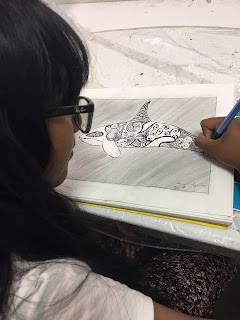Article by Bhavini Patel
Pablo Picasso once famously proclaimed, “Art washes away from the soul the dust of
everyday life.” Art has been an outlet for many to turn to when they want to create work. Art has
been a part of our daily lives for as long as man has existed. It has given people the practice of
observing, producing, and appreciating the different forms of expression. Art has always been an
integral part of our culture that provides us with a deeper understanding of emotions, self-
awareness, and more. Artistic creations have bridged the gaps between cultures, and encouraged
critical thinking as well as better communication.
Creating art, using different techniques, and using color can allow one to experience their
full range of emotions. Skill builds feelings within us and helps us explore and interpret our
thoughts and values. When Dr. Mitchell B. Reiss, the President of Washington College is asked
about the impact of art on individuals in an interview with the Huffington Post, he responds,
“Even those of us who can’t put oil to canvas, hold a note or write a sonnet can appreciate and
learn from the artist’s interpretation of the human experience. At their best, the arts strike a
universal chord that suggests that we are not alone in our experience of joy, or grief, or courage”
(Huffington Post). By allowing our emotions to rise within our art pieces, it helps us heal, grow,
reflect, and improve our well beings. The self-awareness that shines through art can lead to
success both personally and professionally.
Art has also been proven to be a coping mechanism for stress. Art Therapy has been
known to relieve pressure in several ways. Girija Kaimal, assistant professor of creative art
therapies at Drexel University conducted a study examining the effects of making art on stress-
related hormones in one’s body. The results found that 45 minutes of creative activity
significantly lessons stress in the body, whether or not one has artistic experience. Any form of
art like drawing or painting can take one’s mind off life’s ruminating problems when they are
focused merely on creating. Many incorporate their issues into their pieces displaying raw
emotion and vulnerability. Additionally, as many experts call it, there is a particular “flow” in
art work that is very beneficial for mental health. It refers to a state of being so engaged in
something to the point where one can be in a meditative state. Furthermore, even just having art
as a hobby whether one is great at it or not, can help maintain balance in one's lifestyle. With the
many obstacles of life and the responsibilities everyone faces on the daily, people sometimes
forget that they need self-care.
Throughout the creative process, artists are continually making decisions to display their
work to the best of their abilities. Artists make essential decisions on how to interpret what they
see through the flow, rhythm, and unity of their piece. They use logic and reasoning to attribute
meaning and value to what they are creating. Due to the massive emotional connection that art
has with us, these choices that are made are deeply passionate to artists and what the piece
personally means to them. David Souza, the author of How the Brain Learns once said, “The arts
are not just expressive and effective, they are deeply cognitive . . . They develop essential
thinking tools — pattern recognition and development; mental representations of what is
observed or imagined; symbolic, allegorical and metaphorical representations; careful
observation of the world; and abstraction from complexity ” (AASA). These aspects of art not
only helps build up our critical thinking skills, but it also strengthens the way we communicate
and share our thoughts and emotions with the world.
Art gives us insight into various cultures. In art there is no barrier between culture or
language, it is simply universal. Art allows us to share our perceptions and in exchange learn
more about other cultures as well. It makes communities more beautiful and makes the spaces we
work in or look at more interesting. It enhances our ability to unleash our inner artist with the
incorporation of any principle of art or element of design. It has given many a coping mechanism
to deal with the obstacles of life and mental health. Art has become a natural part of our world
that has created raw emotion, self-health, and opened the doors for creativity and imagination.
Bibliography
Frank, Priscilla. “Study Says Making Art Reduces Stress, Even If You Kind Of Suck At It.” The
Huffington Post, TheHuffingtonPost.com, 16 June 2016,
www.huffingtonpost.com/entry/study-says-making-art-reduces-
stress_us_576183ece4b09c926cfdccac.
Prey, Barbara Ernst. “The Value and Importance of the Arts and the Humanities in Education
and Life.” The Huffington Post, TheHuffingtonPost.com, 9 Nov. 2014,
www.huffingtonpost.com/barbara-ernst-prey/the-value-and-importance-_b_5788116.html.
“How the Arts Develop the Young Brain.” AASA | Equity,
www.aasa.org/SchoolAdministratorArticle.aspx?id=7378.




